Living with
supraventricular tachycardia (SVT)
Learn about ways to manage SVT, and watch a video with information on how to take charge of the condition.
Ways you can manage SVT
There are currently no FDA-approved, in-home treatments for SVT that can be used when an episode happens.
There are, however, other options to manage SVT.
Outside of a healthcare setting
Vagal maneuvers are simple things you can do to help slow the heart rate and stop SVT episodes. Examples include the Valsalva maneuver (a method of pushing air out) and the diving reflex (dunking one’s face in ice-cold water). Some people find these maneuvers to be helpful, but they may not be right for everyone. Ask your doctor if vagal maneuvers are right for you.
Oral medication (pills taken by mouth) can be taken when an SVT episode begins. They are often the same kind of medications that people take on a regular basis to try to prevent SVT episodes from happening again. These medications may help, but they have not been extensively studied or approved for use in SVT.
Inside a healthcare setting
IV medicines are administered through an intravenous (IV) line. Examples of these medicines include adenosine and verapamil. Some people have side effects with adenosine that feel like a traumatic experience.
Cardioversion delivers an electrical current to stop an SVT episode and reset the heart rhythm back to normal. The current is sent to the heart through patches placed on the chest while the patient is sedated with anesthesia.
People who have multiple SVT episodes may be prescribed oral medication to take on a daily basis to try to prevent SVT episodes. Each medication may have side effects, so it is important to discuss these options with your doctor.
Medical options
Beta blockers and calcium channel blockers are typically used to treat high blood pressure, but they can also help prevent SVT episodes because they can slow electrical conduction through the AV node.
- Examples of beta blockers include metoprolol and propranolol
- Examples of calcium channel blockers include verapamil and diltiazem
Class 1C anti-arrhythmic drugs act directly on the heart’s electrical system.
- Examples include propafenone and flecainide
Procedural option
Catheter ablation burns or freezes the cause of the abnormal rhythm. Ablation works 90% of the time, but it is an invasive procedure and may not be right for everyone. Only a small number of people with SVT undergo ablations.

Have a heart-to-heart with
your healthcare provider
Only you and your doctor will know the best way to manage your SVT.
The SVT Impact Profile can help get your conversation started.
Be your own SVT advocate
In matters of your health, it’s important to be a good advocate for yourself. This starts with learning all you can about SVT. There is a range of information, resources, and things you can do to help you or someone you care for better manage the condition.
Connect with SVT care professionals
Discuss a treatment plan with heart health experts, such as a cardiologist or electrophysiologist. You can also schedule checkups with your primary doctor to discuss how your treatment is working. Start a list of questions that you may want answered. Don’t be embarrassed to ask questions if you don’t understand something. You can also complete and download the SVT Impact Profile and bring it to your healthcare provider.
Talk to family and friends
The unpredictable nature of SVT may take a toll on you. And having to go to the emergency department for an episode can be agonizing, time-consuming, and even embarrassing for some people. Let people close to you know how you are feeling and how they can support you.
Enlist a driver
in case of emergency
You may feel weak during an SVT episode, so it is best not to drive yourself if you need to go to the emergency department. Make sure to map your drive to the emergency department for your driver.
Helpful resources
and support for you
If you’ve ever tried covering up your SVT episodes, you’re not alone. An online community, such as support groups on social media platforms, or an in-person gathering can create shared experiences and understanding. You may also find it helpful to get information from trusted organizations that are dedicated to supporting people with health conditions like SVT.
Get a wearable device
Wearable devices can help keep track of your heart rate both during and between episodes.
Consider participating
in a clinical trial
Advances in SVT treatment and management are being made every day. You can search ongoing trials that you may be eligible for at ClinicalTrials.gov. Use search terms like SVT, supraventricular tachycardia, paroxysmal supraventricular tachycardia, PSVT, tachycardia, or arrhythmia.
Become an SVT
advocate for others
Sharing your SVT story can help more than you know. Send us an email to learn how to get involved and share your SVT experience with other people living with the condition.
SVT Awareness Day is June 7th!
SVT Awareness Day happens during World Heart Rhythm Week. It is dedicated to raising awareness and increasing recognition of the impact of SVT on peoples’ lives.

Watch this video for more information on how you can take charge of your condition.
Taking charge
of SVT
For many people, not being able to predict when the next episode will happen can cause serious anxiety.
Although most episodes of SVT occur for no reason, episodes may be brought on by alcohol, caffeine, smoking, drug misuse, lack of sleep, or stress. Still, more research is needed to say with certainty whether factors trigger episodes. Some people make dietary or lifestyle changes with the hope that they might prevent future episodes.

Stay up to date about SVT with education, resources, and support.
By submitting your email, you confirm you are over 18 years of age and consent to receive future emails from SVTHeartToHeart.com and Milestone Pharmaceuticals. View the Terms of Use and Privacy Policy.
References
1. Fahie, S. Verapamil. StatPearls. 2023. 2. Singh, S. Adenosine. StatPearls. 2023. 3. Helton, M.R. Am Fam Physician. 2015;92(9):793-800. 4. Colucci, R.A. Am Fam Physician. 2010;82(8):942-952. 5. Mayo Clinic. Supraventricular tachycardia. 2022. 6. Page, R.L. Circulation. 2016;133(14):e471-e505. 7. Al-Zaiti, S.S. Crit Care Nurs Clin North Am. 2016;28(3):309-316. 8. Wood, K.A. Eur J Cardiovasc Nurs. 2007;6(4):293-302. 9. Milestone Pharmaceuticals data on file: PSVT Patient Journey Market Research conducted by Triangle Insights Group, 2020. 10. Milestone Pharmaceuticals data on file: PSVT Patient Education/Disease Message Testing, 2023. 11. Mayo Clinic. Cardioversion. 2022. 12. Mayo Clinic. Beta blockers. 2023. 13. Mayo Clinic. Cardiac ablation. 2022. 14. Bibas, L. CMAJ. 2016;188(17-18):E466-E473. 15. Sequeira, N. Heart Rhythm. 2020;17(5 Pt B):854-859.
Back to top

